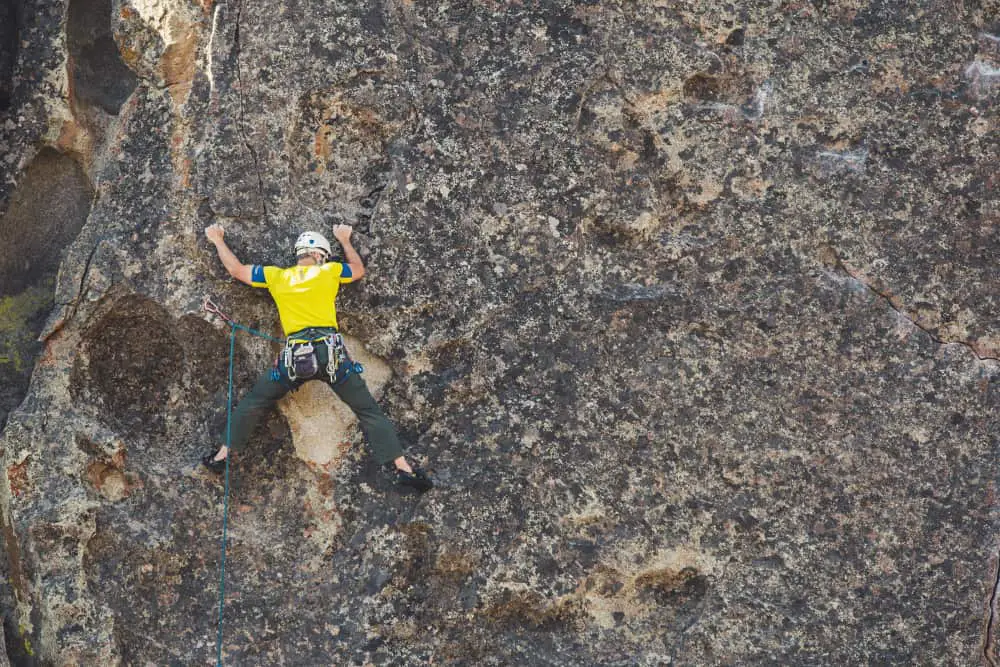
Rock climbing has a long history, so let’s look at 38 facts you may or may not have heard before. The facts here may include scientific studies to provide evidence. I have also written full, detailed articles related to some of the facts mentioned that can give you more insight. Anyway, here they are.
1. A 12 year old, Italian climber called Tito Traversa died because of faulty Quickdraws
Some climbers have used a rubber band to keep the quickdraw from being wonky as it is being clipped. Occasionally, as you’re throwing all your gear around while you’re travelling, the carabiner may work its way out of the mesh and is held on by the rubber band. You may not be able to tell this at a glance. Once weight is put on that carabiner you can fall. This is where we should remind ourselves to check all gear before you climb. The safety equipment we use is LITERALLY the only thing from surviving and certain death in some cases.
2. Climbing is a sport that debuted at the Tokyo Olympics in 2020
20 male rock climbers and 20 female rock climbers from around the world were involved in the 2020 (2021 due to COVID-19) Olympics. The overall scores were based on speed, lead and bouldering. Some people approve of the decision to bring climbing into the Olympics under these terms, however some say it destroys the art of climbing. The reason climbing has been added to the Olympics could be because of one major reason – the younger adult. The International Olympic Committee has the youth of today as their main target, so their wish is for the Olympics to inspire them and therefore they’ll make the future of the Olympic Games even more entertaining. The average age of a rock climber is around 23 years old so climbing will fit perfectly into the sort of sport they would add to the games. Check out an extensive article I’ve written about climbing in the Olympics by clicking here.
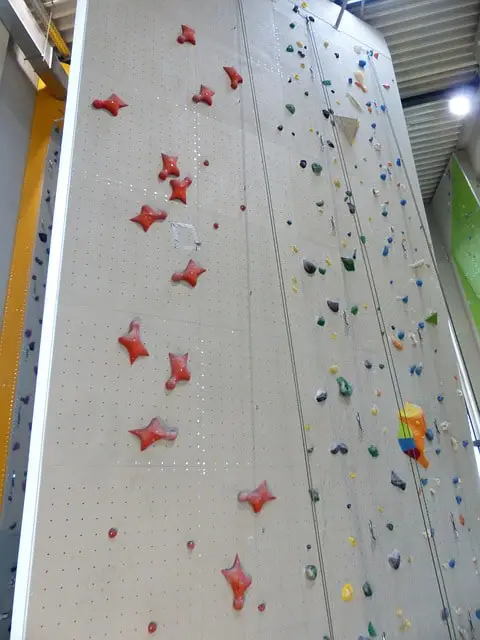
3. There are five main types of rock climbing that are graded
Free climbing, mountaineering, ice and mixed climbing, bouldering, and aid climbing. Bouldering has 5 different grading systems:
- The V scale aka The Hueco Scale is the most used system in North America which includes gradings from V0-V17.
- The B system is used in North America and uses only three grades; B1, B2, B3. B3 being the hardest.
- The Fontainebleau system founded in France and is most widely used in Europe.
- The UK Technical grading system is used in the United Kingdom for trad climbs and was once used for bouldering.
- The Dankyu System which is used throughout Japan. The name originates from martial arts. The system is split into two – Kyu and Dan. The easiest Kyu grade is 7-Kyu and the hardest Kyu grade is 1-Kyu. The next hardest grade is 1-Dan. The Dan scale then ascends as the climbs become harder. The hardest ever recorded Dan was a 6 Dan. People often shorten the grades when typing or texting, e.g.: 3Q will mean 3-Kyu, and 1D will mean 1-Dan.
Aid climbing has 2 different grading systems:
- The Original grading system which ascends from A0 to A5. The grade is based on things such as how good are the foot placements, how many body-weight placements are there in the climb etc.
- The Clean Scale. This scale is used for a certain type of aid climbing – one that does not allow the use of pitons, bolting gear or other types of climbing gear that may affect the rock in a negative way.
4. A study has shown that rock climbing is as good for cardio as running 8-11 minutes per mile.
In 1997 a study was conducted by the British Journal of Sports Medicine to find out how good rock climbing was for cardio-respiratory fitness. 14 climbers were involved in the study, and it was found that the heart rate and energy expenditure of the participants involved when climbing an indoor rock climbing wall was similar to that of running 8-11 minutes per mile. The study concluded that “These data indicate that indoor rock climbing is a good activity to increase cardiorespiratory fitness and muscular endurance”. I’ve written an article covering the topic of how good rock climbing is as a workout which you can read by clicking here.
5. Rock climbing can be practised indoors on artificial rock or outdoors on real rock
This is pretty much a given. Most people understand that rock climbing is practised indoors and outdoors but it still remains a fact! You can find out 5 different types of rock that climbers find outside by clicking here.
6. Climbing can help a child’s development by improving motor skills, balance and coordination while building social relationships
While climbing, we are learning more about the weight of our bodies, how to use it in certain ways and general coordination for our hands and feet. In children this is also true, more so in fact because they learn faster than most adults. Most of the time children are rock climbing in groups and therefore it builds the relationships they have with each other. Safety is of utmost importance when you go climbing with children. I’ve written an article covering safety and some general tips regarding rock climbing with children which you can find by clicking here.
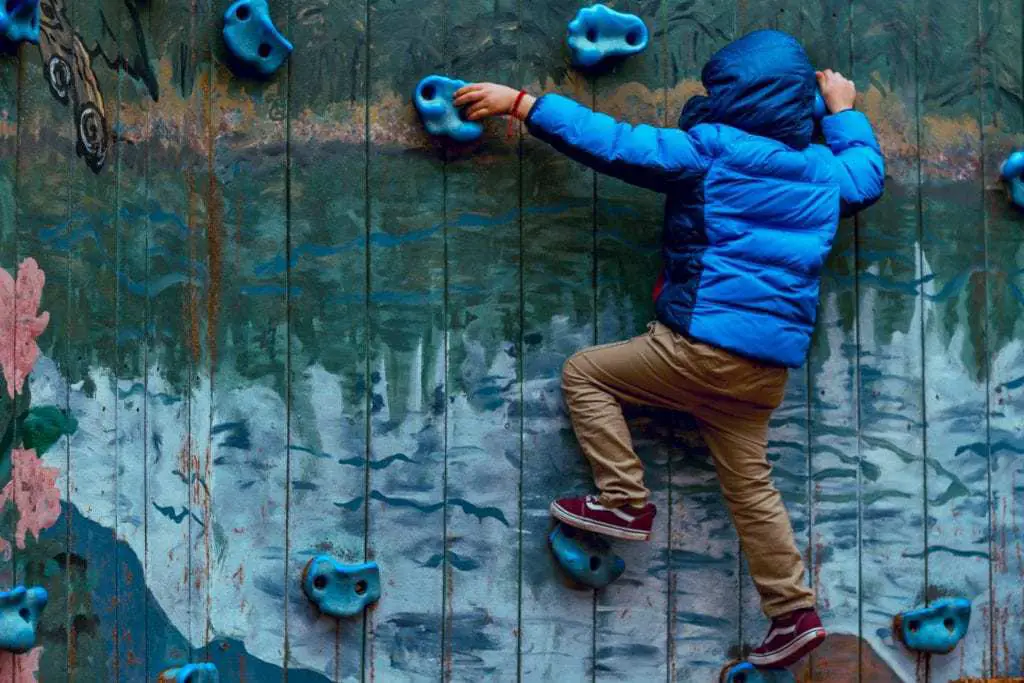
7. Climbing can help cure having a fear of heights and a fear of falling
Many people actually START rock climbing for the specific reason to either cure their fear of heights or falling, or just to reduce the amount that the fear affects them. Having a fear of heights (acrophobia) or a fear of falling (basophobia) is actually quite common, however this doesn’t mean it’s desirable. I’ve got a whole article helping you through your fear of falling/heights when climbing which can be found by clicking here.

8. There are two different types of ice that can be climbed when ice climbing
These are called alpine ice and water ice. Alpine ice, which is usually found on mountains, is easier to climb than water ice, but is usually found on longer routes. Water ice, which is usually made up of a waterfall or something similar, requires a lot more technique to climb. Ice climbing is quite different to your normal rock climbing as it involves the use of picks, crampons, ropes and other equipment that may or may not be found in other types of climbing. There are actually a few artificial ice climbing gyms around the world. For a full article on ice climbing click here.
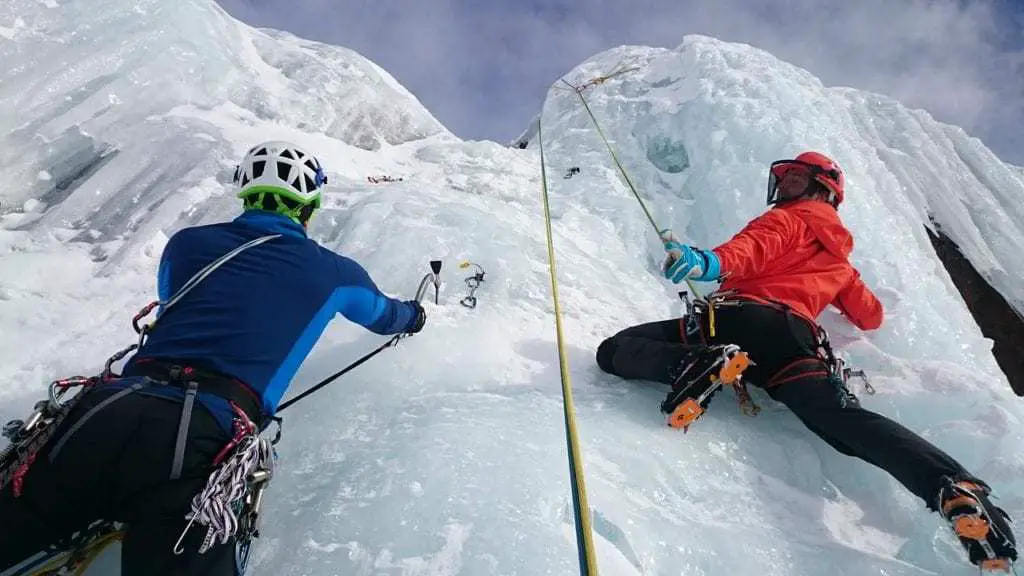
9. Liquid chalk is favoured over normal climbing chalk when deep water soloing (AKA psicobloc)
Imagine being 15 foot up on a wall above water with your chalk bag around your waist and you fall. Once you land into the water, your chalk will be useless and so will the bag until it dries! So what’s an alternative? Liquid chalk is made by combining a form of alcohol and normal chalk powder. It’s a lot less messy, a lot easier to carry around with you, and has less chance of being ruined if you land with it in water. I’ve written a very detailed article on deep water soloing which you can read by clicking here.
10. In 2018, porters who worked on Mount Everest brought down 14 tons of human excrement from locations such as base camps
One thing you may not even think about regarding Mount Everest is that people poo and there’s a lot of people who climb Mount Everest every year. Cleaning up Mount Everest isn’t an easy task, so we have to applaud these people for their commitment to keeping one of the 7 wonders of the world clean from human waste.
11. Limestone, which is a type of rock that is commonly ascended by climbers, turns into marble when it’s heated or under intense pressure
Marble is a metamorphic type of rock, which means it’s created when pressure or heat is applied to another form of rock – in this case it’s limestone. Other types of metamorphic rock include gneiss which was originally granite and quartzite which was originally sandstone.
12. It has been shown in a study that rock climbing is not bad for your hands
A study conducted on 27 recreational climbers and 35 non-climbers has shown that climbing seems to have no long-term lasting affects for the joints in your hands. The study examined “whether rock climbing leads to metacarpal and phalange modelling in the form of increased cortical thickness as well as joint changes associated with osteoarthritis”. It was concluded that “The results suggest that climbers are not at an increased risk of developing osteoarthritis compared with non-climbers. Climbers, however, do have greater cross-sectional area as well as second moment of area. Greater total width, but not meduallary width, indicates that additional bone is deposited subperiosteally. The strength of the finger and hand bones are correlated with styles of climbing that emphasize athletic difficulty. Significant predictors include the highest levels achieved in bouldering and sport climbing”. These quotes can be found in the study linked above. Find out how to soothe your sore hands after rock climbing by clicking this link.
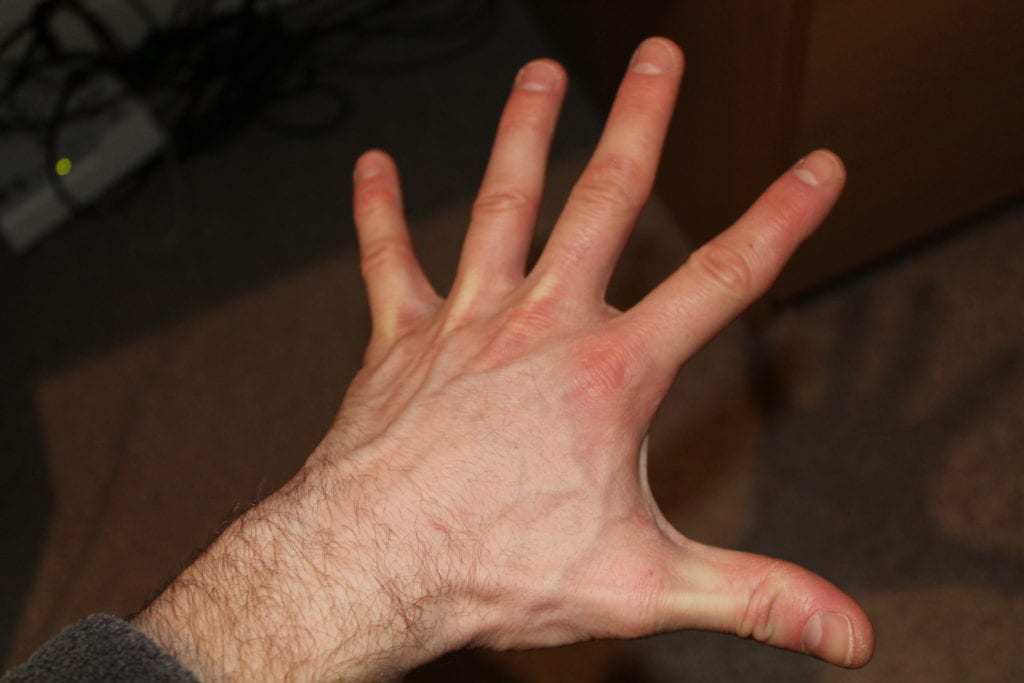
13. Interestingly, climbing contributes to bigger hands
Research shows that there is a larger cross-sectional area on the bones in a rock climbers’ hands along with a greater total width than the average man. The same quote from a study in fact 12 mentions “Climbers, however, do have greater cross-sectional area as well as second moment of area”. This then means that climbing increases hand size.
14. Bouldering becomes highballing after 15 feet (approximately 4.5 meters)
Highballing becomes free-soloing after 40 feet (approximately 12 meters). This is generally accepted throughout most of the climbing world. There are a few climbers that believe the term “free-soloing” can also be accepted on trickier highball climbs.
15. Schurman Rock is believed to be the first ever artificial climbing wall and was made in 1939 in Seattle
It was made by cementing a load of rocks together and has been climbed by thousands of people over the last 80 or so years.
16. There are at least 14 different types of Rock Climbing
There are many different types of rock climbing, 14 of them being
- Bouldering
- Highballing
- Free-soloing
- Lead climbing
- Mountaineering
- Sport climbing
- Traditional climbing (aka trad climbing)
- Top rope climbing
- Aid climbing
- Free climbing
- Rope soloing
- Multi pitch climbing
- Deep water climbing
- Ice climbing
To find out more about each of these type of climbing you can read a detailed article I’ve written by clicking this link.
17. On average around 30 people die from rock climbing each year
This is found by looking at the data supplied over 55 years, from 1951 to 2012 (data cannot be found from 2006-2011). “Climbing” is an umbrella term for bouldering (indoor and outdoor), rock climbing (indoor and outdoor), climbing buildings, roped climbing, mountaineering etc.
18. Yosemite Valley is home to the highest free-solo climbing wall face called El Capitan
El Capitan (aka El Cap) is one of the most feared mountains to free-solo climb and has a near vertical rock face. It’s located in Yosemite Valley, California and has a rock face at around 900 meters high. On June 3rd 2017, it was first climbed free-solo without protective equipment by none other than Alex Honnold, probably the most famous rock climber in the world at the moment. It took Alex 3 hours and 56 minutes to complete the climb.
19. Rock climbing can improve mental health for problems such as depression, ADHD and anxiety
According to the UK NHS website, rock climbing is a treatment for depression. This is apparently due to a heightened sense of self-esteem, the sense of accomplishment you receive when you complete a challenge, and the feeling of self-control. Rock climbing also has the ability to help you feel in the moment which is very similar to a method of meditation called mindfulness. Spending time outdoors has been shown to improve symptoms of people with ADHD, therefore rock climbing outdoors can help relieve these symptoms. This is also one of the ways of how it treats anxiety and depression. You have to use your mindfulness when on a climbing wall to stop yourself from falling. Because of this it keeps you thinking about the moment and not worrying about the past or the future. For a more detailed article about how climbing can help your mental health then click here.
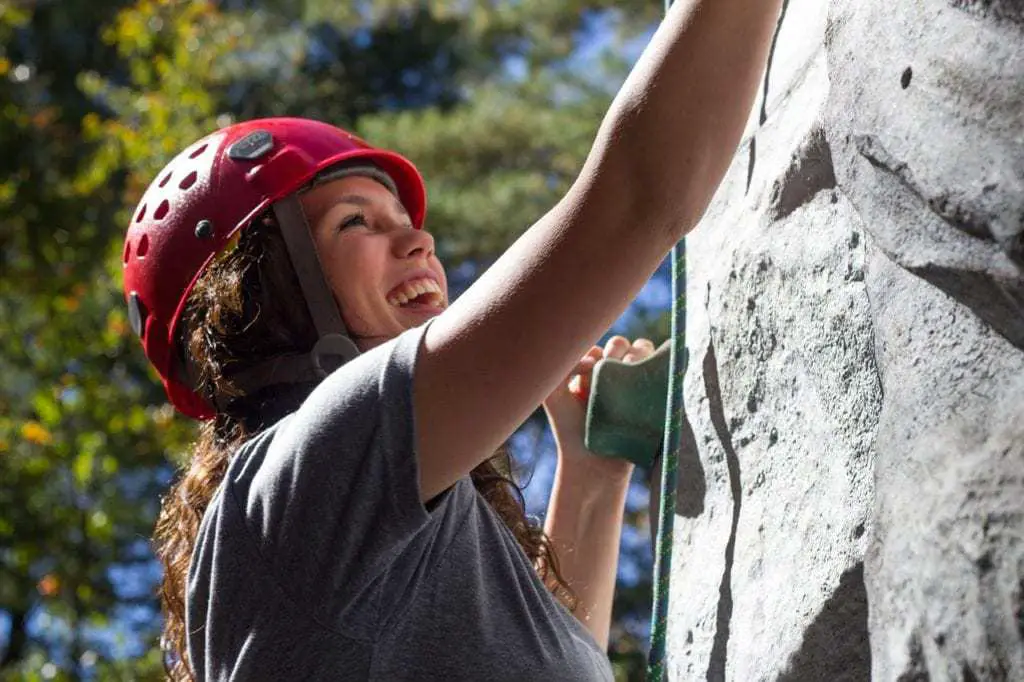
20. Rock climbing is good for posture
When performing overhangs you are using your core muscles a lot which supports your overall posture. There is a grave error, however, that some climbers make when they descend from a climb – they jump instead of climb down the problem. If you jump from a wall 3 or 4 meters high onto a mat, you’re going to be compressing the vertebrae in your spine which is bad for your back and therefore posture. Rock climbing can improve your posture by climbing correctly with controlled technique, avoiding any errors that may cause injury, and descending from a problem by climbing down the easiest route possible. You can find out how rock climbing affects your back by reading this article.
21. Climbing can help you burn fat
If you were to keep the same diet and exercise regime as you do now and add 1 session of rock climbing in per week, you’d be doing more exercise than you were before. Therefore you’d be burning more fat than before and you may be gaining muscle. So, if you’re one for weighing yourself to decide how fat you are then that might not be a good idea here as muscle has a higher overall density to fat (a smaller amount of muscle weighs more than a larger amount of fat). If you were to add in 2 rock climbing sessions a week, you’d lose even more fat and you may even gain more muscle depending on your protein and energy intake. If you would like to take it even further then you may want to think about changing your diet to help repair your muscles and help you burn fat even faster.
22. In a study, rock climbing has shown to be good for lower back pain
Although some climbers actually complain about lower back pain, others believe it can help improve lower back pain and there’s a study to complement this. 30 patients with chronic lower back pain were split into two groups: climbing and control. The patients in the climbing group were made to climb 10 sessions in 8 weeks (at least once a week) for at least 1 hour a session. It was concluded that “Climbing may be an effective and low-cost therapy option for people with chronic low back pain”. Some people however, report that they develop low back pain from climbing and there are a few reasons that this may happen. The first reason is due to jumping down from a bouldering wall rather than climbing down the easiest route. If you fall from a bouldering wall onto your feet, the vertebrae in your spine compress and therefore, over time, you end up with a bad back. Climbing may also cause muscle imbalances if you use more strength than technique which can cause lower back pain.
23. Rock climbing can be particularly bad for your feet if you wear shoes that are too small for you
When rock climbing you may wear shoes that are so small for you that they hurt your toes or your feet. This isn’t a good thing as it can cause different types of injuries in your feet that may become permanent if they aren’t looked at. Bunions can be caused by shoes that are too small and can be surgically removed, however they will most likely come back if you keep wearing tight shoes. Metatarsalgia and Morton’s neuroma can also develop. Metatarsalgia is a condition invisible to the naked eye that can produce a sharp or achy pain around the ball of the foot. Morton’s neuroma is a condition that can be relieved by taking off tight climbing shoes. Morton’s neuroma causes numbness, shooting or stabbing pains, and tingling in the feet. Other conditions include corns/calluses, subungual hematoma, nail bed infections, in-growing toe nails, and toe deformities. For more information on these conditions, or information on how to find the right size climbing shoe, you can head to an article I wrote about this topic by clicking here.
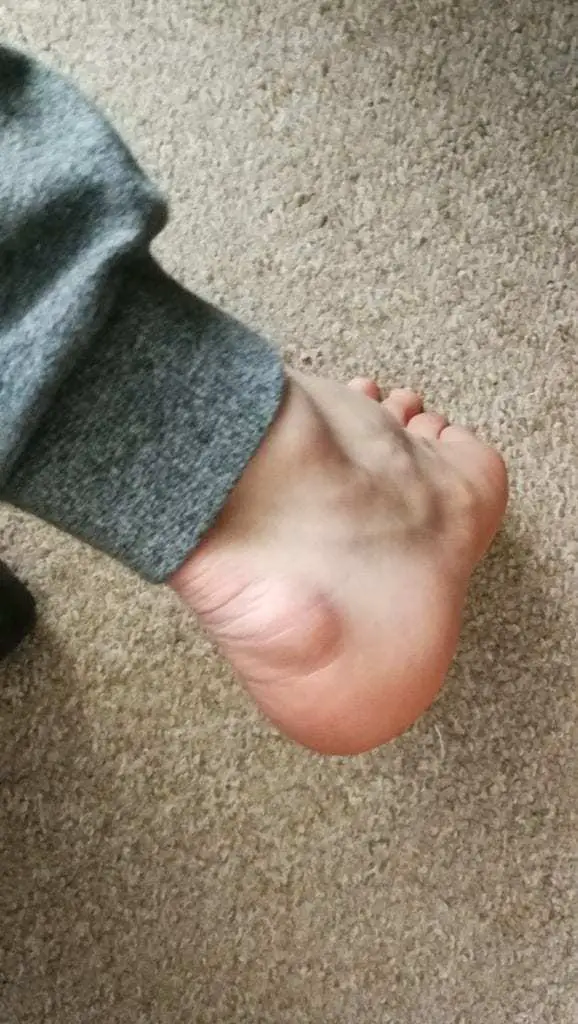
Bunion caused by climbing 
Deformed feet caused by climbing
24. Most rock climbing gyms require a sense of unspoken etiquette
In your local indoor climbing gym there are usually unspoken laws that most people seem to learn quite quickly over their first few climbing sessions, but just in case you missed any we’ll list the main ones here:
- Be aware of your surroundings, people might fall on you.
- If you’re about to climb, make sure your route doesn’t overtake someone else’s route when they have started climbing before you
- Don’t dish out any advice unless someone either asks for it or you offer it and they say they want it
- Don’t hog a wall to yourself – stand back and let other climbers have a go
- Don’t jump onto a climb if someone has just brushed a hold on it – if they’re brushing a hold and you go chalk it up again then that’s pretty annoying
- Don’t yell or shout unless absolutely necessary
- If you’re not sure about something, ask a staff member or an experienced climber
For more information about climbing etiquette or want some tips to help you avoid beginner’s mistakes then you can click this link to an article I wrote.
25. There are three scientific studies that show rock climbing improves your overall mental health
These three studies provide evidence that rock climbing helps relieve symptoms of depression, can regulate emotional disorders such as bipolar, and can combat anxiety and improve self confidence. I’ll list these studies with links to their abstracts:
- Bouldering can treat symptoms of depression
- Sport climbing can regulate emotional disorders such as bipolar disorder
- Sport climbing can help combat anxiety and improve self-confidence
For more information on how climbing can help overall mental health, I’ve written an article which you can read by clicking here.
26. Climbing is a full body workout
Not only participating in climbing targets every muscle group, it also helps your cardio-respiratory system. Climbing is particularly good at building muscles including the latissimus dorsi (aka the lats), the forearms which are an extension of your finger muscles, the core including the abdomen and the surrounding muscles, and the shoulders. To find out just how good climbing is as a workout you can check out an article I’ve written by clicking here.

27. Some climbers use resin to help them grip outdoor holds
This isn’t a common technique as it’s frowned upon in most climbing circles. It’s mainly used in Fontainebleau which is one of the oldest and most popular climbing destinations in the World. In this case it’s usually pine resin from the bark of a pine tree. Resin can actually damage the holds on most outdoor climbs. This is why it’s frowned upon, along with the fact it makes the climb much easier to complete because you have a lot more grip.
28. Freezing your climbing shoes can stop them becoming even smellier
This is because the cause of the smell is bacteria and it does not grow in freezing temperatures. However, it also doesn’t die and therefore will be just as smelly as they were before you put them in the freezer. If you’re going to try to freeze your climbing shoes, remember to place them in a plastic bag first. The overall smell can be treated with a number of methods including scrubbing the inside of the climbing shoe with washing machine detergent. For a full article on how to treat your smelly climbing shoes you can click this link.
29. A basic home climbing wall costs around $500 to build
This is around an 8-10 foot climbing wall at a 45 degree angle so the rockface is in an overhang position. Of course adding more handholds and other more complex parts to the wall would increase costs. This also depends on where you get your climbing holds from. If you get your climbing holds new then you’re looking at a more expensive wall, however you can actually look around online and even ask climbing gyms if they have any old climbing holds they’re willing to sell.
30. Most artificial rock climbing holds are made from a Polyurethane Resin
In the USA it’s also commonly known as Urethane. You have less chance at damaging a polyurethane hold and it’s also cheaper than most plastic based holds. Some holds are also made of wood, ceramic, rock and concrete.
31. According to celebritynetworth.com, Alex Honnold who is probably the most famous rock climber in the World today, has a net worth of $1.5million
This is due to sponsors, money made from his film appearance in Free Solo which is a film surrounding his experience free soloing the 900 metre high surface El Capitan in Yosemite valley. The film earned more than $20million at the box office. Find out the 13 most famous climbers of all time by reading this extensive article.
32. The Lake District in the UK and Fontainebleau in France are home to two of the World’s oldest bouldering areas
Climbing has been practised in these areas for over 200 years and even today these locations attract climbers from all over the world.
33. A pumice stone is very good to help with calluses, alternatively you can use a file
Calluses are those hard areas on your hands and feet that have developed over time due to some form of rubbing or friction. They can be filed down with a normal file, or you can use a pumice stone which works even better.
34. Kids and toddlers can rock climb in various ways
Children can join a parent or guardian on a climbing session. It is advisable to start children climbing on artificial walls with a large safety mat for safety purposes. However, some people may find outdoor climbing for children more preferable because there is less chance that someone will land on your child if they are likely to wander underneath climbers. Many climbing gyms also offer kids group classes. This usually includes basic techniques and rock climbing games for kids that will keep them entertained. To find more information about kids rock climbing you can click this link to an article I wrote.
35. Rain and hot weather make it harder to climb
This is because rain obviously makes outdoor rock slippery. Hot weather can affect indoor and outdoor climbing. Many indoor rock climbing gyms don’t have air conditioning, and some lack a vast amount of opening windows. Therefore, not only are you contending with your own moisture on the holds, you are also battling against the moisture in the air from other climbers’ sweat. God help you if the weather is also humid. Of course, in hot weather it’s worse outside. Limestone is one of the hardest types of rock to climb in hot weather. It’s very slippery due to the moisture in your hands. I’ve written an article about the different types of rock used when climbing which you can find by clicking this link.
36. There are over 20 names and terms for different types of holds
For example, we all probably know or have heard the term jug used when climbing. A jug is an easily grabbed hold that contains a dip in the center. Something every climber wants to hear when they ask “What’s that top hold like?” is “It’s a jug”. Other terms used are edge, volume, pocket, sloper, crimp etc. If you’d like to look at 20 names and terms for rock climbing holds with their definitions you can find them by clicking here.
37. Vegan climbing shoes use synthetic materials instead of suede and leather
Most climbing shoes use different types of rubber for the sole. Leather is the strongest material used for the top of a climbing shoe, but these synthetic materials are a good alternative for those looking for vegan climbing shoes. Many brands provide vegan climbing shoes.
38. Tennis elbow and golfer’s elbow are both common in climbing
Tennis elbow and golfer’s elbow both involve inflammation of the tendons that attach to the elbow, however the difference is in where the tendon is that is inflamed. Tennis elbow affects the outside of the elbow, whereas golfer’s elbow affects the inside. Both are common injuries developed when rock climbing. They can be treated with ice, rest and physiotherapy.
